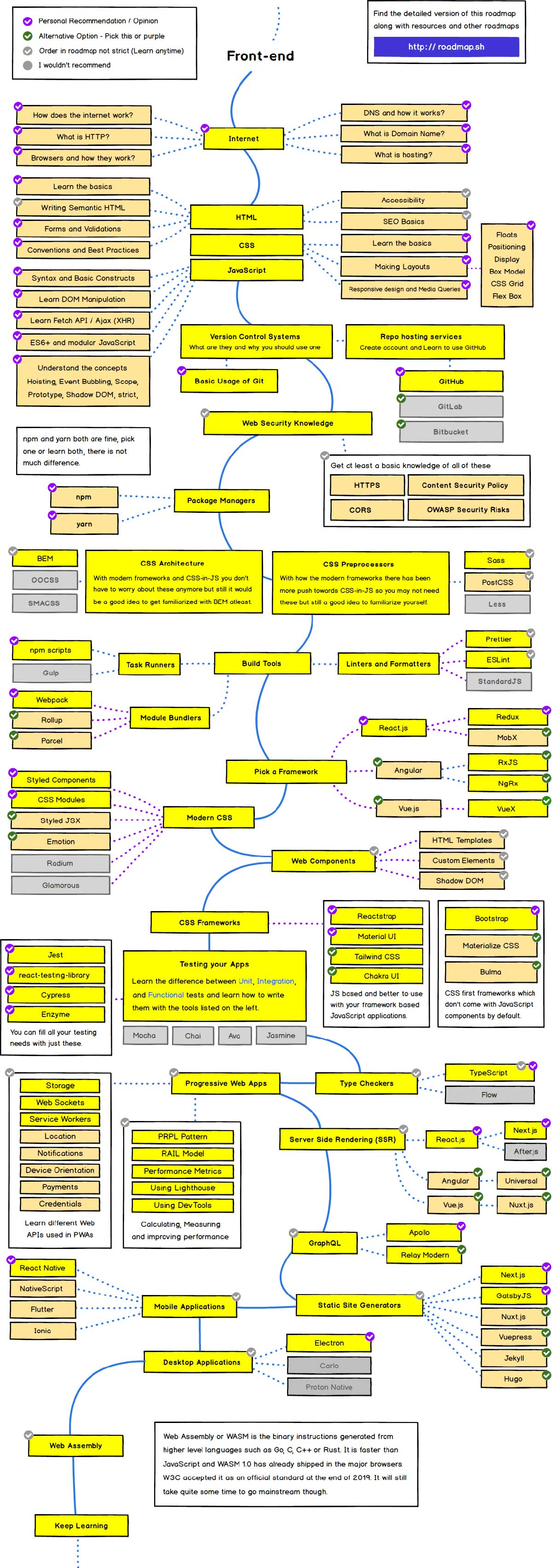If you want to become a Front-End Developer in 2022, but you have no idea where to start you’re in the right place. In this article I’m going to share some of the most essential things to allow you to understand how Front-End development works and how the entire ecosystem looks like: technologies, languages, tools, libraries, frameworks.
- HTML5 basics and semantic tags: It’s like a backbone of web development which allows us to build the semantic structure of websites.
- CSS Fundamentals: Generally used for styling content on webpage. As a result we get styled layouts. The alignment techniques like CSS Flexbox and CSS Grid manage the space and place elements on the page. The Built-in Media Queries directive allows the creation of responsive layouts for different devices.
- Git/Github – Git is a version control system, necessary if you want to work in a team. This solution allows you to track changes in the project. Github is one of a few hosting services to store programming projects’ repositories.
- Terminal/Command-line: Knowing your terminal well will give you full control of workflow. As a Front-End developer you will need the terminal to work with git, install dependencies and run the application.
- Code Editor (Visual Studio Code/Atom/Webstorm): A code editor is simply a tool for writing your code. The extension manager with addons definitely increases your performance and decreases the possibility of creating bugs on application development early stage.

“Step by step guide to becoming a modern frontend developer in 2022” – www.roadmap.sh
- CSS Frameworks: Also good to have knowledge about libraries for easier modern styling. CSS Frameworks like Bootstrap or Tailwind allow to create styled interfaces faster and more efficiently.
- JavaScript: The most important programming language of web development. It’s responsible for the logic layer in the application. Be patient and firstly learn the fundamentals then that choose at least one JS Framework to build more advanced and efficient applications.
- React.js/Vue.js/Angular.js: You can be a little bit confused at the very beginning because there are many popular JS frameworks so far. What is it? Solutions for creating applications according to SPA (ang. Single Page Application) approach. Next.js/Nuxt.js/Universal – equivalents of the above solutions but for SSR (ang. Server Side Rendering) approach.
- npm/yarn: The package managers which make it possible to use external library/framework.
- ESLint, Prettier, Husky: Tools for static code analysis which format code according to predefined rules, reduce errors and display warnings on the development stage. This allows to avoid trash code.
- Jest/Cypress/Enzyme: The libraries for writing unit, integration and functional test on Front-End side.
- TypeScript: It’s a strongly typed programming language that builds on JavaScript, giving you better tooling at any scale. The biggest advantage in comparison to JavaScript is static typing. The typing validation compiler automatically eliminates a range of potential errors in your code.
- Gatsby/Vuepress: One of the most popular static site generators. There is an alternative to database-driven content management systems, such as WordPress and Drupal with high performance.
- Deployment (Netlify, Vercel, GitHub): You can share your application online for free using netlify or vercel.
- Progressive Web App: The approach which let you create web application but with native mobile factors using Web Api (eg. shortcut icon, push notifications, payments, location).
- React Native: The library based on React.js which gives the opportunity to create mobile applications in JavaScript.
To conclude, just keep learning because Front-End Development has a lot of awesome possibilities and secrets 🙂
Let’s do IT!
Miłosz Bauman, Front-End Developer



